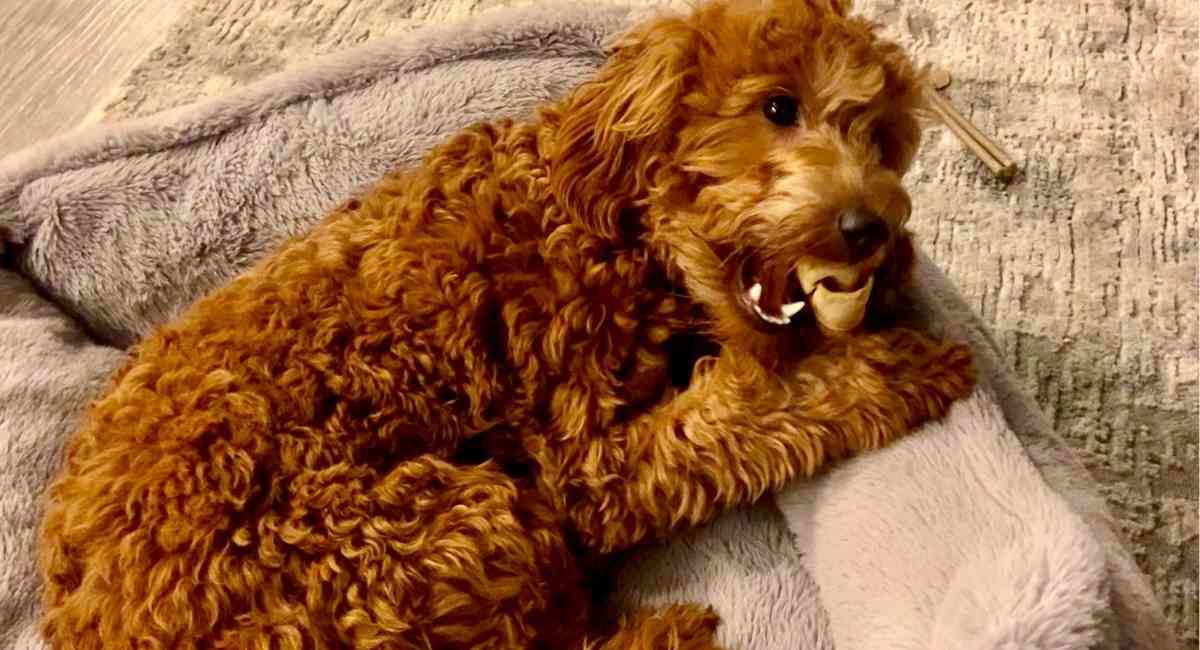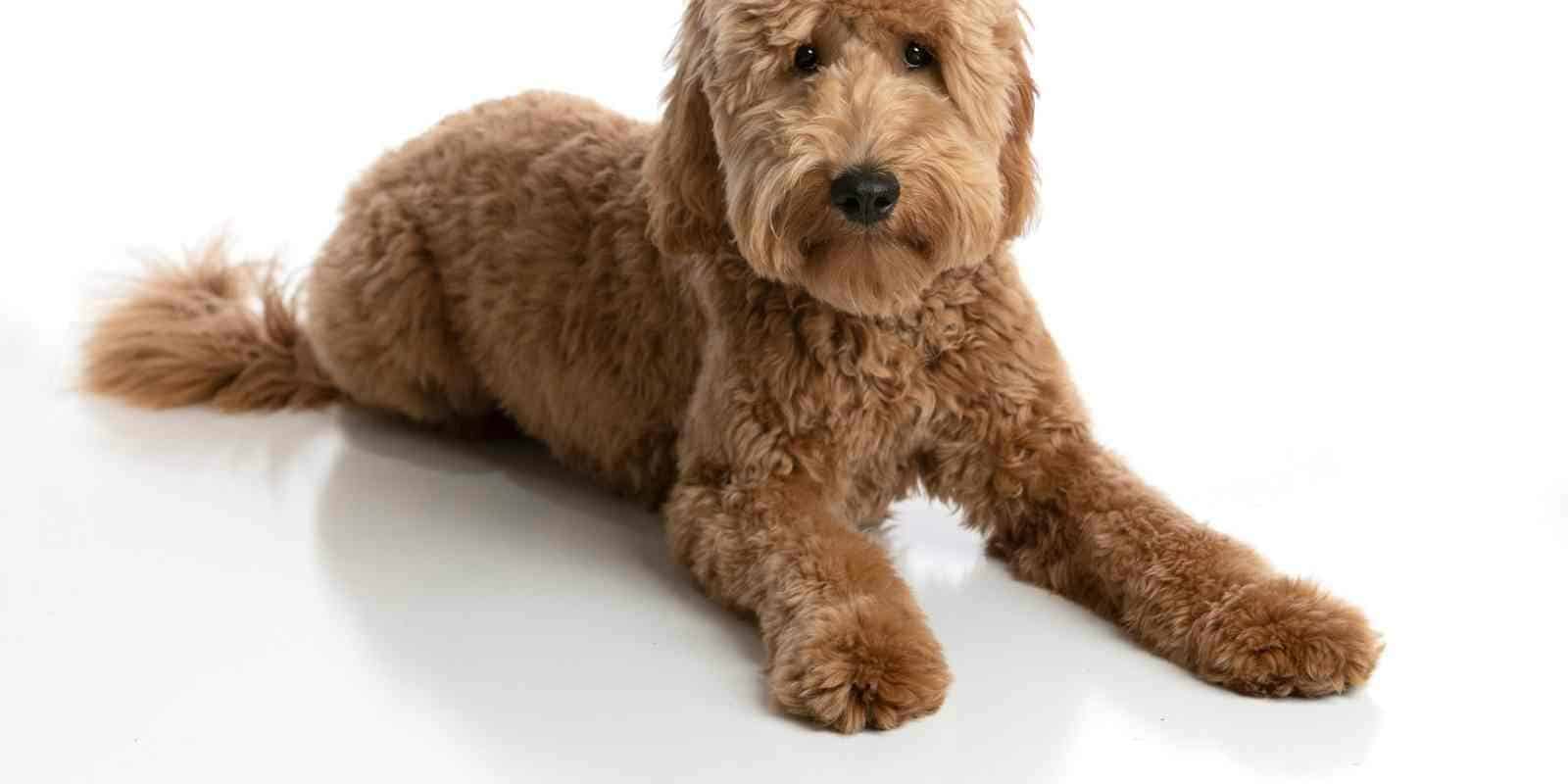An Apricot Goldendoodle is one of the most sought-after types of Goldendoodle. Just like other Goldendoodles, they derive their coat colors from their Golden Retriever and Poodle parents..
The coat of Apricot Goldendoodles is typically described as yellowish in color, like the inside of a peach, or diluted brown. But, this coloring can change with age, as we’ll discuss below. We will also talk about the various generations of Apricot Goldendoodle, highlight some cool facts about these lovable dogs, and more.
What Are Apricot Goldendoodles?
Apricot Goldendoodles get their coat’s distinctive coloring from the Poodle parent.. Their heads are usually large and their muzzle is long and straight with hair around their snout. And they feature dark brown or black physical attributes throughout their body including their nose, eyes, eye rims, and toenails.
Apricot Goldendoodles are the definition of adorable. Not only do they come in different sizes, but the coat colors also differ slightly. Even more interesting is the fact that the coat can change its color as the Doodle ages into adulthood.
While you won’t see a dramatic color change, – your Apricot Goldendoodle won’t turn black! – an Apricot’s coat will often lighten or sometimes darken as they grow older. This happens because they are descendants of Poodles, which go through a coat change as they age, a phenotype that Apricot Goldendoodles have inherited.
Just like other Goldendoodles, Apricot Goldendoodles are very energetic and suitable for an active family. They are equally as smart as their parents and are extremely trainable. These gentle lovers are a big fan of treats and praises, so don’t hesitate to use those during training.
Parents should feed them a healthy, balanced diet to improve their health and coat quality. The quantity should be based on their size or the type of food being fed.
Regular grooming is also required, including monthly bathing, frequent brushing, and constant ear inspections. Their nails should be trimmed from an early age. You can keep their coat short or long, but it should be brushed regularly.

Different Apricot Coat Colors
1. Dark Apricot Goldendoodles
These Apricot Doodles do not change coats, and they remain dark for most of their lives.
2. Light Apricot Goldendoodles
These Apricots have an almost cream-colored coat. The color over time will likely lighten.
3. Red Apricot Goldendoodles
This is the type most people think of when they hear about an Apricot Goldendoodle, making it one of the most popular colors and commonly requested types of Apricot Goldendoodle. This puppy coat changes color as they enter adulthood.
It’s important to know that Red Apricot is a shade of the Apricot Goldendoodle. They often appear reddish-brown, and over time, their coat color changes to light red or apricot, while Apricot Goldendoodles’ coats will lighten over time.
Apricot Goldenoodle Coat Types
The texture of an Apricot’s coat ranges from wavy to curly and straight, depending on what parent gene they inherit. Typically it’s the Poodle’s gene most breeders want for a Goldendoodle offspring.
Curly Coat
An Apricot Doodle with a curly coat is almost every breeder’s preference because their curly features make them more hypoallergenic. Dander is rarely on their curls, and they shed less. Regular grooming and daily brushing are needed for this type of coat.
Wavy Coat
A wavy coat is much easier to groom but less hypoallergenic than curly coats. This is a common coat for Goldendoodles and is sometimes called fleece coats. It’s likely Apricots with this type of coat inherited the Retriever’s gene.
Straight Coat
A straight coat Apricot Doodle is the rarest, though they are becoming more popular. This type of coat requires trimming to prevent tangling and to make brushing easier.
Sizes of Apricot Goldendoodles
The size of the Doodle depends on which parent’s gene they inherit. They come in various sizes, and there’s something for everyone.
Standard Apricot Goldendoodle
- Largest size of Apricot Doodles
- Can weigh up to 45-75 pounds
- Stand between 21-24 inches tall
- Size group is medium-large
Medium Apricot Goldendoodle
- Weigh 30-45 pounds
- Stand 12-15 inches tall
- Size group is medium
Miniature Apricot Goldendoodle
- Weighs 15-30 pounds
- Can be 12-15 inches tall
- Size group is small
- Mini Apricot is popular with first-time pet owners
Perfect for small apartments
Petite Apricot Goldendoodle
- Weigh 15-40 pounds
- Can be 10-18 inches tall
- Their size group is small-medium
- A mix of Poodles, Golden Retrievers, and Cocker Spaniels
Toy Apricot Goldendoodles
- Weighs under 15 pounds
- Under 11 inches tall
- Size group is small
- Perfect pair with kids
- One of the most popular and sought-after sizes of Apricot Goldendoodles
How Are Apricot Goldendoodles Bred?
Apricot Goldendoodles are first-generation Goldendoodles, often represented as F1. This basically means that they were bred directly by a Poodle and a Golden Retriever. This generation of Goldendoodles is 50% Poodle and 50% Golden Retriever.
There’s also another generation of Apricot: the F1B. The B here stands for “backcross,” meaning this generation was bred by crossing an Apricot Goldendoodle back to an Apricot Poodle. They are 75% Poodle and 25% Golden Retriever.

Facts About Apricot Goldendoodles
- They can be multicolored. While some people prefer a one-colored Apricot Doodle, most people gravitate towards those that are multicolored. They usually have white patches on their chest and legs. There’s also a rare occurrence where they are completely or mostly white with the apricot color. This is called an Apricot Parti Goldendoodle.
- Compared to other types of Goldendoodles, Apricot Doodles are not as expensive.
- Before adopting an Apricot Goldendoodle, know the advantages and disadvantages of adopting over buying. Do some research to see if adopting a dog is the right choice for you..
- They are not 100% hypoallergenic, but no dog is. Some Apricot Goldendoodles shed more than others.
Health Issues Affecting Apricot Goldendoodles
We will shed some light on what to expect health-wise when you own an Apricot Goldendoodle. Some of these will not be limited to Apricot Doodles alone, but all Goldendoodles in general.
1. Cancer
Goldendoodles can be prone to cancer, which can be traced back to the genes of their Golden Retriever parent. Whether it is curable through drug therapy or surgery depends on the type of cancer.
It is quite possible for cancer to be non-malignant, and oftentimes, the signs don’t really reveal themselves. Treatment will be based on the type of cancer, its location, age of the dog, etc.
It’s important to know if your Goldendoodle’s parents have a history of cancer in their line. This is possible if the breeder you purchased your dog from is reputable. Also, make sure your dog has a healthy diet and regularly visits the vet. If there’s a history of cancer in either of your Doodle’s parents, you should consult with your vet.
2. Von Willebrand Disease 1 (VWD)
This is a commonly-inherited bleeding disorder affecting Poodles and, therefore, Goldendoodles. Affected dogs have a deficiency of Von Willebrand coagulation factor (vWf) — less than half of the level that is considered normal. This protein is essential for normal blood clotting. Dogs with 35% less of the normal vWf will experience mild to moderate signs of bleeding disorder.
The symptoms include:
- Occasional nosebleeds
- Stiffness or signs of lameness if the bleeding occurs in the joint
- Easy bruising, etc.
Genetic testing by breeders is essential to determine if the Goldendoodle is a carrier of this disease. Carriers of this disease do not have these symptoms or are not directly affected. When these carriers are bred with another carrier of the same disease, there is a higher possibility of it affecting their offspring.
3. Food Allergies
This happens when the system of your Doodle reacts to a particular food in the wrong way. This is a result of hypersensitivity towards a specific food product. Goldendoodles are commonly allergic to certain foods such as dairy, eggs, beef, chicken, soy, lambs, etc.
The symptoms may manifest as a form of gastrointestinal problems and skin irritation. The gastrointestinal system is affected because that’s where the consumption and digestion of the food eaten are involved. The symptoms include:
- Nausea
- Diarrhea
- Vomiting
- Bloating
- Weight loss
Other symptoms include:
- Dry, scaly skin
- Hives
- Hair loss
- Itchiness around the paws and ears
- Frequent biting and licking of the skin
- Inflammation around the ears, paws, lips, and face in general
- Coughing
- Seizures
- Watery eyes and runny nose
- Restless
- Frequent head shakes
A way to prevent this is to test your dog’s allergies, which can sometimes be environmental allergies because the signs are similar. It’s important to contact your veterinarian after you notice these symptoms.
Another way to prevent bloating is not to exercise your Goldendoodle immediately after feeding. You can also use a bowl that forces it to eat more slowly.
4. Hip Dysplasia
Hip dysplasia affects one or both of the hip joints. This happens when the hip’s ball and socket joint don’t fit properly. This joint malalignment will cause inflammation or painful arthritis and is a genetic disease often affecting big and heavy dogs.
Goldendoodles may not show any signs of this until they are older, but be on the lookout for bunny hopping, running with the hind legs together, taking more time to stand up, not letting you touch the hind of their body, unable to jump as often, etc.
The treatment of hip dysplasia can be surgically treated, and it is quite expensive. You can take preventive measures such as:
- Do not overwork or exercise your Goldendoodle
- Watch the weight of your Goldendoodle
- Know the medical history of your dog before buying it
- Feed your Doodle a correct diet
5. Ear Infections
Goldendoodles have long, floppy ears mostly covered by hair, and the structure of their ear makes them prone to this infection once every six months. These infections often result from bacteria, yeast, moisture, ear mites, or swimming.
Symptoms include:
- Frequent head shakes or tilt
- Yellow or bloody discharge
- Foul odor in the ear
- Hair loss
- Frequent scratching of the ear
You will need a trip to the vet to get rid of this infection. Treatment may include oral antibiotics, medicated ear cleansers, and anti-inflammatory drugs if the case is severe.
To prevent this, always keep your Goldendoodle’s ears dry after a bath or swim. Inspect your dog’s ear from time to time to catch early signs.
Conclusion
An Apricot Goldendoodle is a great companion for everyone. Even though they are prone to some health issues, they can live a completely normal life beyond their life expectancy (10-15 years) as long as proper diet and care are involved.
For more tips on how to care for your doodles, read our collection of Caring for Your Doodle articles.

